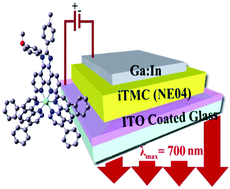Ruthenium phenanthroimidazole complexes for near infrared light-emitting electrochemical cells†
Abstract
By adding different electron donor moieties to the ancillary ligand in ruthenium(II) phenanthroimidazole complexes, we successfully designed near infrared light emitting complexes suitable for light emitting electrochemical cells (LECs). By using a single-layer LEC architecture and incorporating a novel top contact via melted deposition, working devices were obtained without the addition of any hole or electron transport layer. The resulting devices exhibited a dramatic reduction in the turn-on voltage from 3.1 V to 2.3 V, which is the lowest value observed in the ruthenium phenanthroline family. With the substitution of suitable groups on the ancillary ligand, the electroluminescence wavelength was shifted from the red (617 nm) to the near Infrared (NIR) region (700 nm), with the highest efficacy of 0.45 cd A−1 and external quantum efficiency (EQE) of 1.367%. These values are the highest for NIR-LECs based on ruthenium polypyridyl complexes reported so far.


 Please wait while we load your content...
Please wait while we load your content...